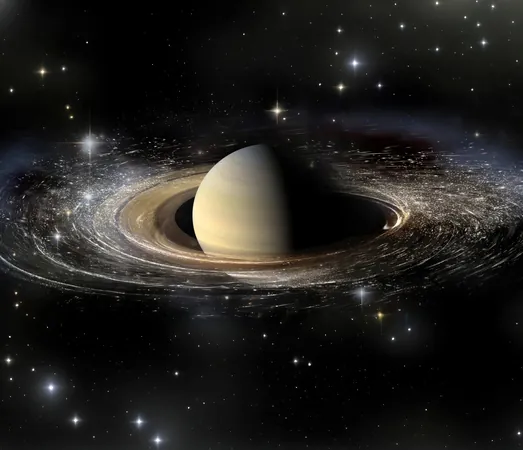
Saturn's Latest Surprise: 128 New Moons Discovered with Enigmatic Orbits
2025-03-21
Author: Wei
Saturn and Its New Moons
Saturn, the mesmerizing jewel of our solar system, has taken center stage once more as astronomers unveil a staggering find: the planet now boasts 274 known moons, following the identification of 128 new satellites with peculiar orbits. This astonishing update has officially positioned Saturn ahead of its closest rival, Jupiter, which has 95 confirmed moons.
Prominent researcher Dr. Edward Ashton, a postdoctoral fellow at the Academia Sinica Institute of Astronomy and Astrophysics in Taiwan, led the charge in this groundbreaking discovery. The findings were solidified by the International Astronomical Union (IAU), which meticulously confirmed each moon’s orbit around the gas giant.
Dr. Ashton emphasized the rigor of the validation process: “You need to be able to prove that the object is in orbit around the planet.” The pivotal observations were conducted using the state-of-the-art Canada France Hawaii Telescope in 2023, showcasing the advancements in astronomical technology facilitating these revelations.
The Mystery of Irregular Moons
The newly identified moons are categorized as ‘irregular’ due to their tilted and often retrograde orbits, with many measuring just a few miles across. Astronomers utilized a sophisticated “shift and stack” method to detect these subtle, faint moons. This technique aligns multiple images, enhancing the visibility of the minute celestial bodies’ trails.
The bizarre trajectories of these moons suggest a tumultuous history marked by cosmic collisions. Researchers postulate that a major event occurred roughly 100 million years ago, propelling debris outward and leading to the creation of these smaller moons. Some fragments might even be remnants from bodies that originated from different areas of the solar system, now encircled by Saturn after encounters with other celestial entities.
A Nod to Norse Mythology
Among the newly identified moons, a specific group has been designated as Mundilfari, in homage to a deity from Norse mythology. Notably, 47 of the recent discoveries fall within this category. Michele Bannister, an astronomer at the University of Canterbury in New Zealand, remarked, “This is implying we could be having collisional events, and we’re seeing the shrapnel in the population of tiny moons.” Researchers suspect that these moons might have originated from a significantly larger moon that faced a historic collision.
Unraveling Cosmic Origins
These findings offer a unique lens into the dynamic interactions within our early solar system. Team member Brett Gladman from the University of British Columbia elaborated on the significance of tracking these moons’ characteristics: “It’s akin to mapping out a family tree of lost moons,” he explained. Researchers study similar orbital patterns to unveil possible familial connections among these celestial objects.
The Search for More Moons
Experts believe that there may be even more undiscovered moons lurking beyond Saturn’s majestic rings, potentially stretching up to 18 million miles (29 million kilometers) from the planet. Some of these clandestine satellites might be as tiny as a fraction of a mile. Future observations utilizing powerful instruments such as the James Webb Space Telescope may unlock further insights into these elusive companions, despite their diminutive size and faintness.
In Search of Names for the New Moons
Currently, the new moons are labeled with preliminary numbers and letters. According to Dr. Mike Alexandersen from the IAU, “Whoever discovers them gets the right to name them.” The tradition involves using mythological names, drawing inspiration from folklore across various cultures, including Norse, Gallic, and Inuit.
A New Chapter for Saturn's Moon Family
All these newcomers orbit outside Saturn’s largest moon, Titan, which measures 3,200 miles (5,100 kilometers) across and overshadows these new finds. However, their minuscule size does not diminish their scientific importance. Many of these moons exhibit eccentric orbits, serving as crucial markers for ongoing investigations into planetary formation, the origins of Saturn's striking rings, and the complex gravitation interplay surrounding this gas giant.
The study detailing these incredible discoveries has been published in the Research Notes of the American Astronomical Society, and it continues to ignite curiosity and excitement among both professional astronomers and casual stargazers. Each new moon brings with it a cascade of questions about the cosmos and our understanding of it.
Prepare to witness even more astonishing discoveries as we probe deeper into Saturn's captivating realm!


 Brasil (PT)
Brasil (PT)
 Canada (EN)
Canada (EN)
 Chile (ES)
Chile (ES)
 Česko (CS)
Česko (CS)
 대한민국 (KO)
대한민국 (KO)
 España (ES)
España (ES)
 France (FR)
France (FR)
 Hong Kong (EN)
Hong Kong (EN)
 Italia (IT)
Italia (IT)
 日本 (JA)
日本 (JA)
 Magyarország (HU)
Magyarország (HU)
 Norge (NO)
Norge (NO)
 Polska (PL)
Polska (PL)
 Schweiz (DE)
Schweiz (DE)
 Singapore (EN)
Singapore (EN)
 Sverige (SV)
Sverige (SV)
 Suomi (FI)
Suomi (FI)
 Türkiye (TR)
Türkiye (TR)
 الإمارات العربية المتحدة (AR)
الإمارات العربية المتحدة (AR)